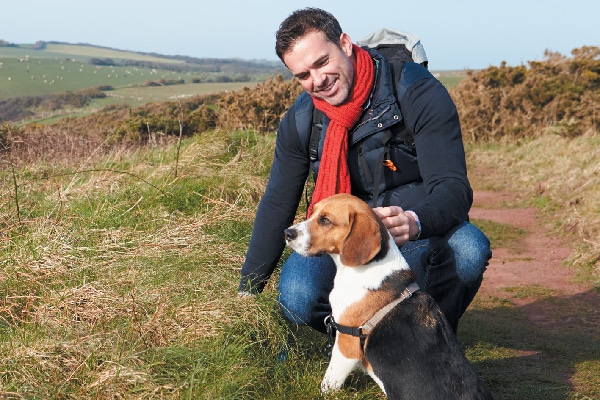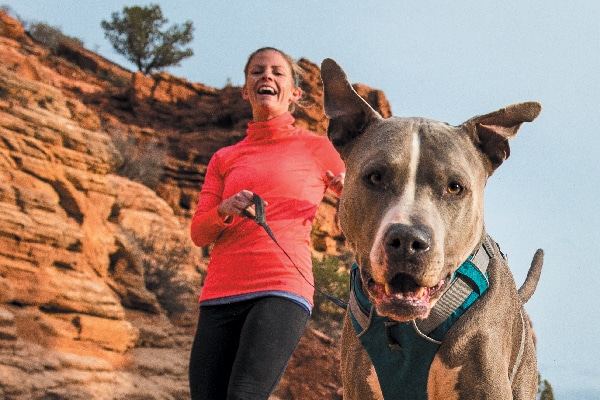Mollie is an experienced hiker, despite having 4-inch legs. The Dachshund mix has been hitting the trails most of her life. “She will be going as hard at the end of a four-hour hike as the beginning,” Doug Gelbert says of his 4-year-old dog. “Of course, she will also be asleep in the back seat at the end before I can get the car started.” Mollie has lots of company. The Facebook group Hiking With Dogs, which Gelbert founded, has more than 32,000 members. “It’s a good place to see a lot of happy dogs,” says Gelbert, a Flat Rock, North Carolina, author who has published more than 20 guidebooks on hiking with dogs.
Indeed, a walk in the woods benefits canines and humans.
“Hiking and backpacking is a real quality-time bonding experience,” Linda Mullally says. A Carmel, California, resident and lifelong outdoor enthusiast, Mullally and her husband, David, have co-authored seven books on hiking or backpacking with dogs, with another due out this fall.
Exploring the backcountry with your dog can breed a new and deeper appreciation for nature. “It is a chance to observe the natural world through the dog’s senses,” Mullally says. “You notice plants and trees and birds that you would otherwise pass by. You pay more attention to the way a stream flows and what surrounds it. You soak up scenery at a slower pace every time you pause while your dog investigates a new smell.”
Lessons from hiking with dogs

Hiking with dogs can be fun — if you do the right prep work! Photography ©monkeybusiness | Getty Images.
The sense of adventure and unpredictable nature of the trail make hiking an exciting and humbling learning experience. In his 30 years of hiking with dogs, Gelbert says he’s been lucky on trail, despite seeing bears, rattlesnakes and porcupines, which he calls “the most dangerous animal because they are easily caught by dogs with unhappy endings.”
But he remembers a blunder while hiking in the New Jersey Pine Barrens. “I managed to turn a simple 8-mile-loop hike into something over 20 thanks to trying shortcuts,” Gelbert recalls. “My dog never complained once.” Lesson: Stick to the trail, and be prepared for a hike that takes longer than anticipated.
Mullally, who has hiked with dogs all over the United States and Canada, has seen her dogs chase two bear cubs up a tree with mother bear at the dogs’ heels. The worst experience, she says, was when her off-leash Siberian Husky mix, Shiloh, briefly disappeared and ate something that resulted in a serious pancreas condition — and a $10,000 vet bill. Lesson: Use a leash.
Despite the blunders, the thrill of hiking always brings them back to the trail. “Bad moods melt away watching the way they experience a trail with such joy,” Gelbert says of hiking with dogs. “They never come to the trail to get away from something or to work something out or other such human baggage. They are always having a good time, and that is infectious.”
What to know before you hike with your dog
“Any dog can be a trail dog,” says Gelbert, “so don’t be afraid to get started.” Before you start, blaze a trail to your veterinarian’s office to evaluate your dog’s health and fitness level. Consider vaccination schedules and age (immune system and bones should be fully developed in young dogs; for older dogs, concerns include hip dysplasia and arthritis). Next, bone up on these skills:
- Train with short walks (less than one hour). Gradually increase distance, changing terrain and elevation; tender paw pads need time to toughen. Use positive reinforcement.
- Make sure your dog is socialized and obeys basic commands, including “heel,” “sit” and “stay.”
- Take a canine first-aid course and assemble a first-aid kit.
Rules to follow when you’re on the trail with your dog
Once you are ready, start with an easy trail that’s dog friendly. Many places, including most national parks, do not allow dogs on trails.
Here are some rules to live by when you are out on the trail with your dog:
- Rest often. “Pace your hike and backpack distances to your dog’s fitness and stamina level, not yours,” Mullally advises. „
- Offer water and food frequently. A general guideline is 8 ounces of water every hour. Your dog will need about 30 to 50 percent more food than normal while hiking.
- Feed low-fiber, high-fat and high-protein dog foods in small amounts every two to three hours. „
- Watch for signs of distress, such as limping, rapid panting (a symptom of heatstroke) and a dry nose (a sign of dehydration). “Dogs often try beyond their capabilities to keep up,” Gelbert warns. „
- Practice good trail manners. Be in control of your dog at all times, yield the right of way to others, and control barking. „
- Double bag your dog’s waste and pack it out. As Mullally says, “There is no Poop Fairy.”
Beware of these trail hazards when hiking with dogs

Make sure to find a dog-friendly trail near you before you start out. Photography by Steve Tague Studio.
- The American Veterinary Medical Association notes 20 diseases outdoor enthusiasts should understand, including the tick-borne Lyme disease and Rocky Mountain spotted fever. “Dogs should be on appropriate flea and tick prevention,” says Ailien Britt, DVM, a veterinarian at Webster Groves Animal Hospital in
St. Louis, Missouri. - Some active ingredients to look for in flea and tick medications include afoxolaner, fipronil, permethrin and selamectin. Monthly treatments can be topical spot-on liquids or oral pills and chewable tablets. Some also offer protection against heartworm disease, and many of the spot-ons are waterproof. Check with your veterinarian.
- “Know the type of wildlife in the area,” Dr. Britt advises. Be sure your dog’s rabies vaccination is up to date. Learn to recognize hazardous flora, including stinging nettle and barbed foxtail.
- Bring fresh water. Drinking from ponds, lakes and streams can cause illnesses, such as giardiasis and leptospirosis, Dr. Britt says.
- Most importantly: Know your dog’s limitations. “I probably would not take my Shih Tzu on an uphill hike that requires a lot of maneuvering, but my Lab mix would have no problem,” Dr. Britt says. “It is the same as humans: You are not going to go on a 10-mile hike through rough terrain and hills if you are not capable of walking one mile from your house. The most important thing is to have common sense. I have known too many humans who overestimate their dog’s capabilities and are carrying their 80-pound dog back to the car.”
How to care for your dog after the hike is over
Once your hike is over, there are still a few things you should do: „
- Allow time for cooldown and recovery. „
- Check for cuts and scrapes, as well as ticks, burrs and other hitchhikers; bring a dog brush or comb and tweezers. „
- Wipe down a wet or dirty dog with clean, dry towels. „
- Offer water and food to replenish.
Don’t have a dog to hike with? Hike with shelter dogs
You don’t have to have a dog to hike with one. Libby Wile has been hiking with dogs for seven years through volunteer programs at her local animal shelters.
“Seeing a dog that was anxious or shy in the shelter really break out of their shell, wag their tail and enjoy a hike is the best trail experience,” says Wile, senior director of programs at the American Hiking Society in Silver Spring, Maryland. Through outreach and enrichment programs, such as the People and Animal Cardio Klub (P.A.C.K.) in the District of Columbia and Hiking Hounds in Asheville, North Carolina, volunteers take shelter dogs on weekly group hikes.
“The dogs get time away from the shelter, which can be a stressful environment,” Wile says. “They get exercise and a chance to be out in nature. They also get a chance to be social with the public and be exposed to and comfortable with things they might not be used to. When we arrive back to the shelter after a hike, the dogs are calm, tuckered out and ready to meet their forever family.” Wile benefits, too. “I get great joy out of seeing the dogs happy and eager to explore,” she says. “I also get an opportunity to connect with nature, get exercise and hang out with others that love dogs and hiking. These shelter programs are really a win-win for every person and animal involved.”
Bucket-list hikes for you and your dogs

Build up to harder hikes with your dog. Photography Courtesy David S. Mullally.
So now you’re ready to get out and go hiking with your dogs. What are some of the best dog-friendly hiking trails near you? Gelbert, whose latest book 500 Places to Hike With Your Dog Before She Tires You Out is expected this year, notes two of his best trail experiences as inspiration after you and your dog have gained some experience:
- The top of Mount Elbert in Colorado is the highest point a dog can legally go in the contiguous United States. “It was an 18-mile round trip, so that probably wasn’t what they were expecting when they jumped out of the truck,” Gelbert says of his dogs. “But they spent a good amount of time looking around on the way up and at the top, just like everyone else.
- “Hiking in slot canyons in Utah is always fun since it is definitely different from our usual hikes,” he says. “I always wonder what [my dogs] must be thinking in those places.”
Want to learn more about hiking with dogs and dog-friendly hikes near you?
- AmericanHiking.org — American Hiking Society
- HikeWithYourDog.com — includes a list of dog-friendly trails
- Outdoors.org — Appalachian Mountain Club
- PetFirstAid4U.com — Pet first aid classes
- AVMA.org — American Veterinary Medical Association
Thumbnail: Photography ©Michael DeYoung | Getty Images.
St. Louis-based freelance writer Martha M. Everett has lived on both coasts covering everything from Washington to Westminster. Like her Keeshond-Italian Greyhound mix, Trooper, she’s treat motivated, but only one of them has tried to eat a grandfather clock.
Tell us: What are your tips for hiking with dogs? Where do you and your dog like to hike? What are some dog-friendly hikes near you?
Editor’s note: This article first appeared in Dogster magazine. Have you seen the new Dogster print magazine in stores? Or in the waiting room of your vet’s office? Subscribe now to get Dogster magazine delivered straight to you!
Read more about hiking with dogs and enjoying the great outdoors with your dog:
- Tips to Prepare for Camping with Dogs
- 5 Things You Should Know If You Hike With Your Dog
- 5 Ways to Prepare for a Hike With Your Dog
The post Hiking With Dogs — Tips for Bringing Your Pup on the Trail appeared first on Dogster.
No comments:
Post a Comment